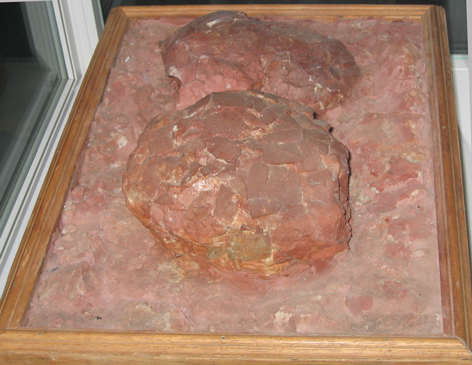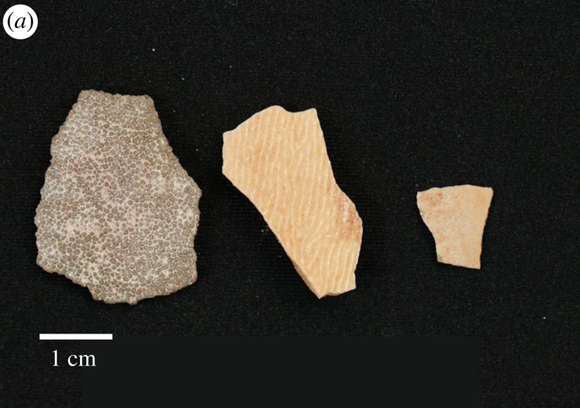Cracking the Code – What Eggs and Eggshells Can Tell Us
A researcher based at the University of Edinburgh has produced a “cracking” assessment on the use of eggs and eggshells of living and extinct archosaurs to obtain information about ancient environments, the behaviour and biology of vertebrates that may have lived many millions of years ago.
Writing in the open access Royal Society Open Science, Shaena Montanari (School of GeoSciences, Edinburgh University), has reviewed how the use of eggshells in the modern and fossil record allow an interpretation of a variety different archosaurs and other amniotes across deep time, providing a unique record of ancient environments and ecosystems.
A Nest of Large Dinosaur Eggs

Picture Credit: Everything Dinosaur
Archosaur Eggs – Overlooked Body Fossils
Biologists studying living vertebrates and palaeontologists studying extinct animals can look at the skeleton (fossil bones) and make deductions. Other materials in both modern and ancient environments can be overlooked. Take for example, the shelled eggs of archosaurs, the Squamata and potentially monotremes, these, if they are preserved in the fossil or archaeological record, can provide a wealth of information to help support other areas of research.
Palaeontologists know that dinosaur eggs were not that much different from the eggs of living birds. Eggs provide another biogenically created material that can be used to reveal specific information about the egg-layers and the environments they live in when assessed with different types of geochemical, morphological and molecular techniques.
The matrix surrounding the holotype fossil material of the dromaeosaurid Deinonychus (D. antirrhopus), contained fragments of fossil eggshell, later assigned (in all probability due to the low energy depositional environment and taphonomy of the fossil material), to Deinonychus. This was the first record of a dromaeosaurid egg, however, this material was either overlooked or perhaps ignored when the dinosaur bones were first found back in the 1930s.
Examples of Fossil Eggshell
Picture credit: Royal Society Open Science
The photograph (above) shows three examples of dinosaur eggshell fragments from the Gobi Desert. Such items may be overlooked in the quest for more substantial body fossils but different eggshell types possess varied forms of ornamentation and can help to establish more information about the fossil biota. The three pieces in the photograph, probably represent different types of dinosaur (from left to right titanosaur, oviraptorid and potentially troodontid). Microscopic analysis of the shell structure, along with pore density and isotope data can provide information about the ancient environment and inferred nesting behaviour of long extinct creatures.
Isotope Analysis
Isotope analysis from eggshell can even provide information on the diet of the animal that laid the egg.
Post-doctoral researcher Shaena, explains in the paper that archaeologists can learn a remarkable amount about early human settlements by examining ostrich eggshells. Ostrich eggshell is found in association with human food waste dumps, as bead decorations, sometimes associated with ritual burial or as containers for water. Archaeological sites as far apart as China, India and north Africa have yielded Ostrich egg remnants. These pieces of shell could be used to provide direct evidence of environments where early communities settled.
A Selection of Whole or Virtually Complete Dinosaur Eggs
Picture credit: Royal Society Open Science
The photograph shows a variety of fossil archosaur eggs from Mongolia (a) three bird eggs from the Gobi Desert, (b) a pair of unidentified theropod dinosaur eggs from the Cretaceous of Mongolia (AMNH FR 6513). Photograph (c) shows an oviraptorid egg (Cretaceous of Mongolia -AMNH FR6508) and (d) is a probable Ornithopoda egg, again from the Cretaceous of Mongolia (AMNH field number 707)
Clumping Isotopes – Learning About Body Temperature
Researchers have developed a technique in which the body temperature of the dinosaur laying the egg can be calculated by plotting the presence of two rare isotopes found in calcium carbonate a key element in the formation of eggshell and a material that has a high preservation potential. From an analysis of the way in which these two isotopes clump together in the same molecule, scientists are able to infer data about the body temperature of the mother.
As the eggs are formed within the oviduct(s) of egg-laying animals, the temperature of mineral formation should reflect the body temperature of the ovulating female. In this way, such studies can inform the debate about endothermy or otherwise within the Dinosauria.
The scientific paper: “Cracking the Egg: The Use of Modern and Fossil Eggs for Ecological, Environmental and Biological Interpretation” by Shaena Montanari and published in the Royal Society Open Science.
Visit the Everything Dinosaur website: Everything Dinosaur.








Leave A Comment